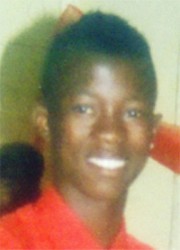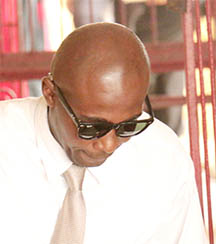Constable Shawn Critchlow, the crime scene rank who processed and photographed the scene where Shaquille Grant was killed, was yesterday unable to tell the court the whereabouts of the spent shells which he said he recovered.
Critchlow was also unable to say what became of the samples which he said he took from swabbing Grant’s skin, as well as Grant’s friends, Romel Bollers, Nicholas Eastman, Jamal Henry called, “Tuna,” and Troy Greenidge.


Critchlow was testifying at the trial of former police constable Terrence Wallace, who is accused of murdering Grant, 17, at Caesar Street, Agricola, East Bank Demerara on September 11, 2012.
Critchlow attested to taking the two spent shells to be tendered as evidence during the Preliminary Inquiry at the Georgetown Magistrates’ Courts. He also recalled signing, uplifting and taking them back to be lodged at the Brickdam Police Station for safe-keeping. However, he was unable to produce them at yesterday’s hearing and could not give an account of their whereabouts. Facing questions from Prosecutor Judith Gildharie-Mursalin about the swabbed samples, Critchlow said he could not recall uplifting those items from the analyst department of the Criminal Investigations Department Headquarters, Eve Leary, after taking them there to be analysed.
After pondering for some time, Critchlow who appeared visibly unsure, said he did not collect the samples but was given the certificate by the analyst.
After being given an opportunity to refresh his memory from his deposition, it emerged that he did in fact collect the samples as well as the certificate from the analyst department.
Justice Navindra Singh, who is presiding over the trial, asked the witness if he had an opportunity to proper refresh himself from his deposition before taking the stand, to which he replied, “partially.”
Justice Singh then adjourned for lunch to give the witness an opportunity to make checks at the Brickdam Police Station to locate the items.
When the case was later recalled however, Critchlow reported that he was unable to locate the items. Asked what could have happened to them, he was unable to give the judge an answer.
Under the circumstances, Justice Singh allowed the rank to step down from the witness stand. The judge adjourned the matter to May 12 at 9AM, to give the witness an opportunity to refresh his memory and to locate the swabbed samples and spent shells to produce for the court.
Recalling September 11, 2012 in his testimony, Critchlow had earlier told the court that on arriving at the scene, he photographed a shed, two spent shells which he saw on the ground and a large quantity of suspected blood on pieces of cardboard which were lying on the ground, under the shed.
The photographs were tendered and admitted into evidence.
Swabbed
He said that about 3PM on the same day, upon instructions from Superintendent of Police Hugh Jessemy, he went to the Georgetown Hospital morgue, where he swabbed the fingers and wrist of both of Grant’s hands.
Later the same day, at the Brickdam Station, he said, he conducted the same swabbing exercise on Bollers, Eastman, Henry and Greenidge.
Critchlow said he handed over the two spent shells and ballistics report to Sergeant Eon Jackson at CID Headquarters, while he took the swabbed samples to the analyst department.
He recalled receiving further instructions from Jessemy on September 14, as a result of which he went back to the morgue and conducted another swabbing exercise on Grant’s body – this time, on his chest and forehead.
Testifying at yesterday’s hearing also was Constable Leon Ashby who recalled being on mobile patrol on the day in question along with Lance Corporal Warren Blue, who received information about a shooting at Agricola.
Ashby said that they, along with ranks from another mobile patrol, went to Agricola. He said upon his arrival, Blue instructed him to cordon off an area. He said he then heard four gunshots go off; one first, and then three in succession.
He said at the time of the shooting, he was sitting in the police vehicle at the cordoned area, with another rank whose name he gave as Constable Adams, the driver of the patrol vehicle.
Ashby said that after the shooting, Blue called Adams, after which they drove some yards further to the scene of the shooting. There, he said, he and Adams complied with Blue’s order to place Grant in the vehicle and take him to the hospital.
According to Ashby, Grant was bloodied when he saw him.
Constable Navaranda Persaud was the last of the three witnesses who took the stand yesterday.
He recalled receiving information as a result of which he contacted Bollers to whom he put the allegation of having a .38 Smith and Wesson revolver with six matching ammunition and discharging a round at several police officers in Agricola.
To the allegation, Persaud said, Bollers responded, “I had no firearm. Those officers lying on me.”
The witness attested also to being on duty at the Ruimveldt Police Station on September 15, 2012 when Blue handed over to him two 9mm Glock pistols, an M15 rifle and three empty magazines. Those items were all tendered and admitted into evidence.
There are seven remaining witnesses to testify from the 21 being called by the state.
Blue and Special Constable Jamal Lewis were also charged with Grant’s murder, but were never arrested. Warrants had been issued for their arrest. While Lewis remains at large, Blue was subsequently shot and killed during a botched robbery on the East Coast Demerara.
The prosecution’s case is that Wallace had ordered Grant and his friends, to lie on the ground and while complying, one of them, Bollers, began removing his cell phone from his pocket. At once, there was a bang which appeared to be a gunshot.
The prosecutor had said in her opening address that Bollers was shot to the head, while Grant was heard saying, “officer, officer, I get shoot.” She said that what appeared to be other gunshots, rang out and following the shooting, Bollers was injured and Grant “was dead.”
The court had heard from Gildharie-Mursalin that according to the police’s version, Bollers was attempting to run away from them, and at the same time, had discharged a round at them from a weapon which he had. “The officers claimed that the action by Bollers was the catalyst for their shooting,” Gildharie-Mursalin had said.
In his testimony on Thursday, however, Bollers said that contrary to what police have claimed, neither he nor any of his friends had any weapon when the police opened fire on them.









